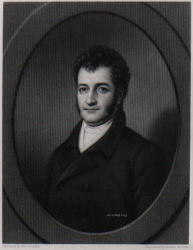George Read Jr. (1765-1836)
 Click on image to enlarge or for higher resolution |
Title/Occupation | Chief Justice (1793-1798) Trustee NCC |
|---|---|---|
| Address | 42 The Strand 110 Delaware 6 The Strand | |
| Artist | Samuel Sartain after Adolf Ulrik Wertmuller | |
| Date painted | <1811 | |
| Credit | Private collection | |
| Married | Mary Thompson (1786) | |
| Parents | George I & Gertrude Ross | |
| Children | George III (1788-1837), William (1792-1873), Gunning Bedford (-1826), Charles (1800-1834), John (1803-1831), Catherine (1794-1826), Mary (1805- | |
Wertmuller was a Swedish born portrait painter who emigrated to the U.S., married the granddaughter of painter Gustaf Hesseius, and lived in Claymont, DE! Samuel Sartrain was the son of British born John Sartrain who pioneered mezzotint engraving in the U. S. | ||
Although there is no Wikipedia entry for George Read Jr. (!), or entry for him in the Biographical and Genealogical History of the State of Delaware, he was active in the affairs of New Castle. As listed by Scharf, Read Jr. was: * Commissioner when the town was created in 1797 * Board of Trustees New Castle Common * Board of Trustees The Academy * Board of Directors, Farmer's Bank, New Castle * Chartered and became Manager New Castle Public Library His most tangible and visible legacy is his grand house at 42 The Strand. Once the grandest house in Delaware, his beautiful home has been attractively restored, furnished and opened to the public by the Delaware Historical Society. School groups have come for generations to learn of early American life. Trip Advisor vistors (rating: 4.5/5) say: "The George Read house, in the historic section of New Castle, is one of the best presented early American homes I've ever visited." "You get a true feel of life when this country was born." "It's a must see." The master's degree thesis by Eliza Wolcott, University of Delaware (1971), George Read (II) And His House, provides a readable biograpy that offers a context for financial and time constraints that affected his building the house. For example, Scharf omitted the fact that Read Jr. was appointed U. S. Attorney from 1789 to 1815 when his son George Read III took his place, and had an extremely active, time consuming and exhausting law practice in New Castle. So active, that it interfered with his home life and his major interest, the building of his house. He had a considerable income from the practice, but more money was always needed for construction bills. George Read Jr., like his father, got his law training in Philadelphia. Houses and friends from there were major influences on him in construction of the house. Preliminary plans for the house ("Plan B"), apparently drawn by his father in 1798, showed a town house of the style common in Philadelphia. Notes on the plan were questions sent to Matthew Pearce of Philadelphia, who responded to George Read Sr. with an elaborated design. George Read Jr's description in Latrobe's journal was not exactly positive, but far better than that for Kensey Johns. About George Read Jr.:
Another of my very good friends is a lawyer.
He has built an enormous house, in
bad taste, and I think, in a very bad situation. For he is close by the water, of which
to enjoy a scanty view he sacrifices a range of the most valuable lots in town, by not
building upon them, and he has then planted a range of Lombardy poplars which
exclude the prospect as effectually as a brick Wall. This Lawyer is a little man, but
exceedingly pompous. He is the very contrast of Bennet. He however gets money, as
do all the Lawyers in Deleware who can get business, and tho' he both neglects his
clients, and sometimes after recovering a debt forgets them is a great and honorable
Man.
| ||
Jim Meek
nc-chap.org 2014, 2015
nc-chap.org 2014, 2015